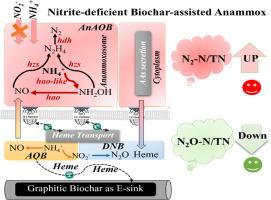Graphitic biochar-anammox achieved by multi-heme-based extracellular electron transfer
IF 12.4
1区 环境科学与生态学
Q1 ENGINEERING, ENVIRONMENTAL
引用次数: 0
Abstract
The anammox process decarbonizes nitrogen removal by avoiding greenhouse gas emissions and organic carbon demand, yet its reliance on nitrification and denitrification undermines these advantages. To address this, we developed a biochar-assisted anammox system that leverages graphitic defects as redox-active sites to enable interspecies, multi-heme extracellular electron transfer (EET). Biochar produced at 800 °C for 4 h (BC800-4h) exhibited the greatest graphitic defect density and the highest electron transfer capacity, uniquely exceeding the daily electron demand for complete ammonium oxidation in the present study. Metagenomic and in vitro assays revealed that BC800-4h promoted hydroxylamine-dependent ammonium oxidation by anaerobic ammonia-oxidizing bacteria (AnAOB) via EET. A cooperative microbial network was identified: AnAOB in suspension supplied heme precursors, while ammonia-oxidizing and denitrifying bacteria colonizing the biochar facilitated heme assembly and transport. This partitioning enabled direct electron transfer to biochar, achieving 62% nitrogen removal without exogenous nitrite and reducing N₂O emissions by 28%. The pore-size-dependent reduction in graphitic defects suggests that large molecular-weight biological channels (>10 kDa) are essential for electron transfer between anammox bacteria and biochar. Our findings indicate an opportunity to develop a biochar-anammox reactor—with suspended AnAOB and a fixed-bed biochar biofilm—to exploit this synergy for efficient and low-emission nitrogen removal.

多血红素基胞外电子转移实现石墨炭厌氧氨氧化
厌氧氨氧化工艺通过避免温室气体排放和有机碳需求来脱碳除氮,但其对硝化和反硝化的依赖破坏了这些优势。为了解决这个问题,我们开发了一种生物炭辅助厌氧氨氧化系统,该系统利用石墨缺陷作为氧化还原活性位点,实现物种间、多血红素细胞外电子转移(EET)。在800 °C条件下生成4 h (BC800-4h)的生物炭表现出最大的石墨缺陷密度和最高的电子转移能力,独特地超过了本研究中完全铵氧化的每日电子需求量。宏基因组和体外实验表明,BC800-4h通过EET促进厌氧氨氧化菌(AnAOB)对羟胺依赖的氨氧化。我们发现了一个合作的微生物网络:悬浮液中的AnAOB提供血红素前体,而定殖在生物炭中的氨氧化和反硝化细菌促进血红素的组装和运输。这种分配使电子直接转移到生物炭,在没有外源亚硝酸盐的情况下实现62%的氮去除,并减少28%的N₂O排放。石墨缺陷的孔径依赖性减少表明,大分子量的生物通道(>10 kDa)对于厌氧氨氧化细菌和生物炭之间的电子转移是必不可少的。我们的研究结果表明,有机会开发一种生物炭-厌氧氨氧化反应器-悬浮AnAOB和固定床生物炭生物膜-利用这种协同作用来高效和低排放地去除氮。
本文章由计算机程序翻译,如有差异,请以英文原文为准。
求助全文
约1分钟内获得全文
求助全文
来源期刊

Water Research
环境科学-工程:环境
CiteScore
20.80
自引率
9.40%
发文量
1307
审稿时长
38 days
期刊介绍:
Water Research, along with its open access companion journal Water Research X, serves as a platform for publishing original research papers covering various aspects of the science and technology related to the anthropogenic water cycle, water quality, and its management worldwide. The audience targeted by the journal comprises biologists, chemical engineers, chemists, civil engineers, environmental engineers, limnologists, and microbiologists. The scope of the journal include:
•Treatment processes for water and wastewaters (municipal, agricultural, industrial, and on-site treatment), including resource recovery and residuals management;
•Urban hydrology including sewer systems, stormwater management, and green infrastructure;
•Drinking water treatment and distribution;
•Potable and non-potable water reuse;
•Sanitation, public health, and risk assessment;
•Anaerobic digestion, solid and hazardous waste management, including source characterization and the effects and control of leachates and gaseous emissions;
•Contaminants (chemical, microbial, anthropogenic particles such as nanoparticles or microplastics) and related water quality sensing, monitoring, fate, and assessment;
•Anthropogenic impacts on inland, tidal, coastal and urban waters, focusing on surface and ground waters, and point and non-point sources of pollution;
•Environmental restoration, linked to surface water, groundwater and groundwater remediation;
•Analysis of the interfaces between sediments and water, and between water and atmosphere, focusing specifically on anthropogenic impacts;
•Mathematical modelling, systems analysis, machine learning, and beneficial use of big data related to the anthropogenic water cycle;
•Socio-economic, policy, and regulations studies.
 求助内容:
求助内容: 应助结果提醒方式:
应助结果提醒方式:


